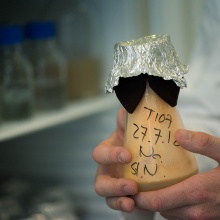1) Optical visualisation of the activity of a mechanosensitive ion channel at the single-molecule level
Mechanosensitive ion channels have been identified as primary molecular transducers of mechanical forces involved in various physiological processes such as touch, hearing, blood pressure regulation and bone development. Aberrant mechanosensitive ion channels are known to contribute to the pathology of diseases such as cardiac dysfunction and osteoarthritis (for reference, see Nobel Prize in Physiology and Medicine 2021).
In a recent study (Wang et al. 2022), we were able to optically track and correlate the lateral mobility and ion-channel activity of a multi-subunit protein complex (TOM, also known as the general protein import pore of mitochondria) in membranes using single molecule TIRF microscopy.
We found that freely diffusing TOM molecules stall when they interact with structures adjacent to the membrane, apparently due to the interaction between their extended polar domains and structures below the membrane. Surprisingly, and simultaneously with the suspension of movement, TOM reversibly changes from an active (fully light) to a weakly active (medium light) and inactive (dark) channel state. The strong temporal correlation between lateral mobility and ion permeability suggests that TOM channel gating is very sensitive to molecular confinement and the nature of lateral diffusion.
Our complex seems to respond not only to biochemical signals but also to mechanical interactions. Together with recent high-resolution cryo-electron microscopy of our complex (Bausewein et al., 2017), our results suggest mechanoregulatory processes in mitochondria that were not previously expected.
Aim:
The aim of this Bachelor or Master thesis is to further confirm this result by comparing the mechanosensitive properties of TOM with those of known mechanosensitive ion channels, such as bacterial MscL and PIEZO1.
Methods:
- Isolation of MscL and possibly PIEZO1
- Protein expression in E. coli
- Single molecule TIRF microscopy
- Matlab
References:
- https://bioengineeringcommunity.nature.com/posts/optical-single-channel-recordings-reveal-correlation-between-lateral-protein-diffusion-and-channel-activity-of-tom
- https://www.nature.com/articles/s42003-022-03419-4
Contact and further information:
- shuo.wang@bio.uni-stuttgart.de
- stephan.nussberger@bio.uni-stuttgart.de
2) Regulation of the pro-apoptotic activity of the BCL2 protein BAX
The release of cytotoxic proteins from mitochondria regulated by proteins of the Bcl-2 family is considered a key event in apoptosis. BAX plays a decisive role. Recent results of our group have demonstrated that BAX is modified with a palmitic acid residue, which promotes insertion of the protein into the mitochondrial outer membrane. Concomitantly, increased palmitoylation of BAX results in increased cellular sensitization to different apoptotic stimuli.
From these observations, new concepts emerge for combating malignant tumor cells in which palmitoylation of BAX is reduced. Aberrant regulation of BAX results in a number of autoimmune disorders (e.g., multiple sclerosis), neurodegenerative diseases (Alzheimer's disease and Parkinson's disease) as well as cancer. Also viruses (e.g. HIV) can disturb the balance.
In this thesis the regulatory mechanism of BAX into mitochondrial outer membranes will be further investigated on the basis of a current bachelor thesis. Special focus will be given to 2-methoxyestradiol-induced apoptosis of bone tumor cells (osteosarcoma).
Literature:
- 2-Methoxyestradiol affects mitochondrial biogenesis and succinate complex flavoprotein subunit dehydrogenase A in osteosarcoma cancer cells. Gorska-Ponikowska, M., Kuban-Jankowska, A., Eisler, S., Perricone, U., Lo Bosco, G., Barone. G. & Nussberger, S. Cancer Genomics Proteomics 15: 73-89 (2018)
- 2-Methoxy estradiol reverses the pro-carcinogenic effect of L-lactate in osteosarcoma 143B cells. Gorska-Ponikowska, M., Kuban-Jankowska, A., Daca, A. & Nussberger, S. Cancer Genomics Proteomics 14: 483-493 (2017)
- S-palmitoylation represents a novel mechanism regulating the mitochondrial targeting of BAX and initiation of apoptosis. Fröhlich, M., Dejanovic, B., Kashkar, H., Schwarz, G. & Nussberger, S. Cell Death & Disease 5 e1057:1-9 (2014)
Methods: cell culture (HEK 293 / Osteosarcoma), standard methods of protein biochemistry
2) Droplet-on-hydrogel lipid bilayers for the optical and electrical measurement of the activity of single ion channels
The aim of the research work is the continuation of a novel experiment (constructed by Lukas Fineisen and Alexander Anton) with which the channel activities of individual channel proteins in so-called droplet-on-hydrogel lipid bilayers can be measured electrically and optically simultaneously.
Literature:
- Lepthin et al. (2013) Constructing droplet interface bilayers from the contact of aqueous droplests in oil. Nature Protocols 8:1048-1057.
- Huang et al. (2015) High-throughput optical sensing of nucleic acids in a nanopore array. Nature Nanotechnology 10:986-991
Methods: Isolation of various channel proteins, protein expression in E. coli and N. crassa, setup of the experiment, single molecule TIRF laser microscopy, possibly MATLAB programming
3) Channel properties of OmpG and VDAC
In gram-negative bacteria, the uptake of substrates from the surrounding medium occurs through
water-filled channel-forming membrane porins. In contrast to the known trimeric porins from 16 or
18 beta-sheets, OmpG is a monomeric protein barrel with only 14 beta-sheets. VDAC, on the other
hand, the most common porin in mitochondrial outer membranes, consists of an odd number of 19
beta strands.
In collaboration with Özkan Yildiz's research group at the
MPI for Biophysics in Frankfurt, the channel
properties of different OmpG mutants will be investigated and characterized both
electrophysiologically and by means of our new high-resolution TIRF microscope on a single
molecule; casually formulated, it should be examined, what can be filled in a OmpG channel, what
goes through. Finally, the phenomenon of nanopreciptation in nanoscale pores, newly observed only a
few years ago, will be investigated at OmpG and VDAC. Preliminary work by our employee Ali
Shademani is available.
Literature:
- Powell MR et al (2008) Nanoprecipitation-assisted ion current oscillation Nature Nanotechnol. 3:51-57.
- Cruz-Chu ER 1, Schulten K. (2010) Computational microscopy of the role of protonable surface residues in nanoprecipitationoscillations ACS Nano 4:4463-74.
Methods: Isolation of VDAC from Neurospora crassa mitochondria, protein expression in E. coli, single molecule TIRF microscopy, single-molecule electrophysiology


